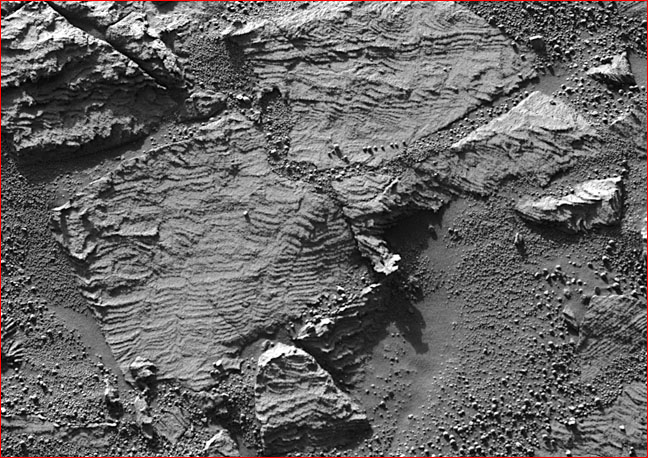
home •
about •
essential guide •
picture of the day •
thunderblogs •
news •
multimedia •
predictions •
products •
get involved •
contact
picture of the day archive subject index
Credit: NASA/JPL-Caltech/Cornel
Aug 10, 2006
"Festoons" Add to Martian MysteriesSwirling and layered Martian "sediments" have inspired planetary scientists to see deposition from shallow water. But the electrical theorists point to a more powerful force active in the Martian past.
The image above comes from the panoramic camera on NASA's Mars Exploration Rover Opportunity, taken on January 2, 2006). NASA scientists describe this as the best example yet of the Meridiani Planum outcrop rocks on the margins of “Erebus Crater”. The image shows well-preserved, fine-scale layering and what geologists call "cross-lamination”.
Of particular interest to planetary scientists are the nested “smile-shaped” patterns that sedimentary geologists call "festoons”. These geometric patterns, they say, imply the presence of small, sinuous sand ripples that form only in water on Earth. According to a news release from the Jet Propulsion laboratory, “these features are the preserved remnants of tiny (centimeter-sized) underwater sand dunes formed long ago by waves in shallow water on the surface of Mars”.
This explanation requires liquid water flowing on the surface of a freezing desert planet. In other words, it requires a vastly different environment on Mars in the past. The explanation is also limited to observations of rocks on Earth that have been interpreted under the questionable geological framework of the uniformity principle: "things happening today are the best indicators of things that happened in the past." Many decades ago this assumption hardened into dogma, and it has led to a litany of unresolved puzzles on Earth. In the space age it is a poor tool indeed for understanding what we find on Mars.
The dilemma has a simple resolution: stop ignoring electrical events inscribed on Mars. Electrical phenomena, both ancient and modern, range from observed global dust storms and electrical dust devils to the vast scars of electrical discharge in the past. For those familiar with electrical scarring phenomena, the most outstanding features on Mars – Olympus Mons and Valles Marineris– shriek of stupendous electrical arcs carving the surface of the planet.
According to the electrical theorists, electrical events vastly more powerful than standard geological processes have shaped the solid planets and moons in the solar system. Atmospheres and surface material have been lifted from one body and fallen back or have been dumped on another. In the process, elements and compounds were modified and dust and melted spherules were formed, to rain down upon a planet. These deposits were then heated by surface electrical currents that changed sand into sandstone, recording the layered deposition and electrical erosion occurring at that time.
Evidence for electrical exchanges between planetary bodies demands that we give up our cozy belief in a nearly eternal, clockwork solar system. The new data from space make clear that Mars was on a different orbit in the past, a consideration that greatly expands the possible explanations for the puzzling images sent to Earth by our Mars probes and surface rovers. Mars must have had a quite different atmosphere and climate in the past. So from this perspective, surface features that show “water action” on the frozen desert planet are not unexpected.
Planetary scientists, however, have been unaware of a fact that could change our understanding of planetary surfaces and the surfaces of other rocky bodies in the solar system. Electrical discharge machining, electrical winds, electrostatic cleaning, and electrostatic implantation can do everything that water can do—and a good deal more. Electrified plasma can mimic the behavior of fluid dynamics, while adding energies many thousands of times more powerful than fluid erosion.
The key to the “festoons” on Mars is evident in the pictures themselves. These curious patterns are surrounded by the now-famous “blueberries” occurring on the Martian surface by the trillions. Experiments have never produced counterparts to the Martian blueberries by depositing hematite from water. But laboratory experiments have produced precise counterparts with electrical arcs.
___________________________________________________________________________Please visit our Forum
The Electric Sky and The Electric Universe available now!

|
|

|
EXECUTIVE EDITORS:
David Talbott, Wallace Thornhill
MANAGING EDITORS:
Steve Smith, Mel Acheson
CONTRIBUTING EDITORS: Dwardu Cardona, Ev Cochrane,
C.J. Ransom, Don Scott, Rens van der Sluijs, Ian Tresman
WEBMASTER: Brian Talbott
Copyright 2006: thunderbolts.info
![]()
home •
thunderblogs •
forum •
picture of the day •
resources •
team •
updates •
contact us

